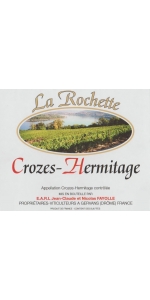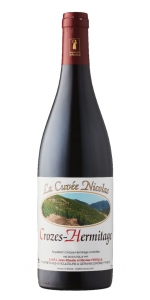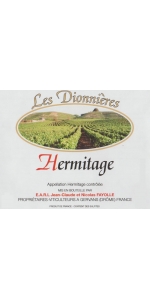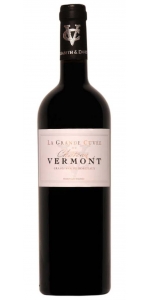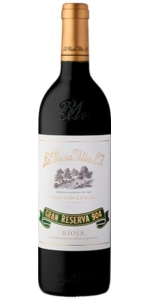Fayolle Crozes-Hermitage Rouge La Grande Seguine 2015
| Country: | France |
| Regions: | Rhone Crozes Hermitage |
| Winery: | Jean-Claude et Nicolas Fayolle |
| Grape Type: | Syrah |
| Vintage: | 2015 |
| Bottle Size: | 750 ml |
Fayolle Crozes-Hermitage Rouge La Rochette is made from 25-year-old vines planted on loess and red granitic soils. 100% Syrah.
Deep ruby red color.
The wine has plenty to offer with red and black fruit aromas, as well as a good minerality.
The finish is long, clean and juicy and offers some white pepper spiciness typical of the best Crozes-Hermitage.
Soil type is red brittle granite and white soil.
Hand harvested in small crates. The grapes are then pumped into tanks (full cluster, not destemmed).
It will stay in this tank for 15 days for the skin contact maceration and the Alcoholic fermentation.
They will also use the "rack and return" technique (delestage).
Then the wine is transfered into neutral French Oak barrels where the wine will complete the Malo-Lactic fermentation.
Fayolle Crozes-Hermitage Rouge La Rochette is made from 25-year-old vines planted on loess and red granitic soils. 100% Syrah.
Deep ruby red color.
The wine has plenty to offer with red and black fruit aromas, as well as a good minerality.
The finish is long, clean and juicy and offers some white pepper spiciness typical of the best Crozes-Hermitage.
Soil type is red brittle granite and white soil.
Hand harvested in small crates. The grapes are then pumped into tanks (full cluster, not destemmed).
It will stay in this tank for 15 days for the skin contact maceration and the Alcoholic fermentation.
They will also use the "rack and return" technique (delestage).
Then the wine is transfered into neutral French Oak barrels where the wine will complete the Malo-Lactic fermentation.
Fayolle Crozes-Hermitage Rouge Cuvee Nicolas is made from 100 percent Syrah.
Deep ruby red color. Nose of red and black currant fruits, pepper, spring flowers, new leather and mineral/earthy nuances. Medium bodied palate of red fruit and spice. Nice balance. Long finish and velvety.
Good match with red meat (beef, lams) or white meat (veal) in sauce, poultry and game meat. Perfect with most cheeses.
Jean-Claude et Nicolas Fayolle Hermitage Rouge Donnieres is made from 100% Syrah.
Made from 40-year-old vines planted on granitic and rocky soils in the Lieu dit "Les Donnieres" at the bottom of the Hermitage's hill.
Intense inky ruby red color.
The wine has plenty to offer with red and black fruit aromas, as well as a good minerality.
The finish is very long, clean and juicy and offers a great spicy mouthfeel.
Soil is clay, silica and round pebbles.
Hand harvested in small crates. The grapes are then pumped into tanks (full cluster, not destemmed).
It will stay in this tank for 15 days for the skin contact maceration and the Alcoholic fermentation.
Tey will also use the "rack and return" technique (delestage).
Then the wine is transfered into neutral French Oak barrels where the wine will complete the Malo-Lactic fermentation.
Delicious with grilled red meat such as venison or lamb and most cheeses.
Vermont La Grande Cuvee Rouge is made from 90% Merlot and 10% Petit Verdot.
Produced from the best parcels of the estate, with low yields and optimal maturity, the wine reveals the expression of the Entre-deux-Mers terroir.
The Grande Cuvee boasts a deep ruby color and displays a pleasant bouquet of red berries and plum highlighting the expression of the dominant Merlot. Rich, refined, fruity and deep in structure, the palate shows good concentration and a harmonious balance. Long flavors of ripe fruits and vanilla nuances give way to an elegant cuvee.
La Rioja Alta Gran Reserva 904 is made from 90% Tempranillo, 10% Graciano
The 2015 Gran Reserva 904 Tinto offers great aromatic complexity, with notes of wild strawberry, red cherry, plum, blackberry and cranberry combined with aromas of tobacco, brioche, ground coffee, caramel, cedar and cinnamon blossom. The alcohol and acidity are elegantly balanced on the palate and its polished, gentle tannins and freshness provide a smooth and refined mouthfeel. Fine, delicate and very long aftertaste, that will continue to be rounded with time in the bottle, making this new Gran Reserva 904 a wine with great cellaring potential.
Especially recommended with all kinds of meat and stews, seasoned fish and desserts with chocolate or red fruit toppings. Perfect as an after-dinner drink.
Review:
A perfumed nose of plums, mulberries, mushrooms, caramel, sweet tobacco and sweet spices. Full-bodied with velvety, fine tannins and lively acidity. Balanced and supple with a creamy texture. Delicate and precise with a long, polished finish.
- James Suckling 97 Points
Made from 38-year-old vines planted on Granitic and stony soils. 100% Syrah.
Wine will be bottled in April 2017.
Deep ruby red color.
The wine has plenty to offer with red and black fruit aromas, as well as a good minerality.
The finish is long, clean and juicy and offers some white pepper spiciness typical of the best Crozes-Hermitage.
Soil type is clay and granit covered with pebbles.
Hand harvested in small crates. The grapes are then pumped into tanks (full cluster, not destemmed).
It will stay in this tank for 15 days for the skin contact maceration, the Alcoholic fermentation and the Malo-Lactic Fermentation.
They will also use the "rack and return" technique (delestage).
Then the wine is transfered into neutral French Oak barrels.
Delicious with griled red meat and most cheeses.
Review:
"Crisp black-plum and bramble notes are accented by pepper, char and anise in this lean, briskly composed Syrah. It's concentrated but spry, framed by grippy but finely edged tannins and a firm, granitic finish. Drink now through 2025. - ANNA LEE C. IIJIMA"
- Wine Enthusiast Magazine (September 2018), 91 pts
- back
• 100% pure Sauvignon Blanc, crafted from grapes grown in the most notable and warmer regions of California’s coastal hills. Each block contributes a distinct element to the blend, resulting in a layered and complex style.
• The harvest dates were determined by physiological maturity, which varied widely in the 2023 vintage due to the wet winter leading to a cool summer. Nevertheless, the extended hang time reduced grapes with low sugar, firm acid, minimal pyrazines, and intense flavor expressions.
• Upon arrival at the winery, the whole clusters underwent a gentle pressing, and the juice underwent a cold settling process for two days. Subsequently, it was racked off the heavy lees into stainless steel tanks, where it underwent a chill fermentation with native yeast – which contributed to the balanced mouthfeel, set against a backdrop of minerality and acidity.
• Following fermentation, the wines remained in tank, with the lees being stirred weekly for nearly four months before the final blend was assembled. No malolactic fermentation was allowed, preserving the vibrant fruit and floral notes, alongside the natural tension characteristics of this blend.
Color:
Medium yellow straw hue.
Aroma:
Asian pear, honeysuckle, passionfruit,
green melon, and a citrus bouquet.
Palate:
Refreshing stone fruit, grapefruit, and tropical flower. This wine has a well-balanced mouthfeel with bright and lively acidity.
Food Pairing:
Oysters on the half shell with mignonette sauce,
niçoise salad, a blue cheese pear tart and crab cakes.
Holocene Memorialis Pinot Noir is made from 100 percent Pinot Noir.
Holocene Pinot Noir Memorialis is a blend of 777, Pommard and 115 clones from MonksGate vineyard in the Yamhill-Carlton AVA, and it saw about 20% new French oak for 16 months prior to bottling. It is always the lighter and more feminine of the two Holocene wines, with red fruits, white flowers, dried herbs, mushroom and forest floor aromatics, bright acidity and a lithe texture, long finish.
By now, everyone knows that the Willamette Valley is an amazing place to grow Pinot Noir. When I relocated from Napa Valley to partner up with Force Majeure Vineyards, I knew I also wanted to start a project where I could focus attention on a varietal and growing region that I loved. Part of the excitement of being in the Pacific Northwest is the ability to have access to so many amazing vineyards and so much diversity, along with the opportunity to push boundaries and try new things – something that is becoming increasingly difficult in other growing regions.
We partner up with a few very small, diverse and amazing vineyards in the Willamette Valley, sourcing fruit from these dry-farmed sites that emphasize low yields, sustainable practices and produce outstanding fruit.
The wines are crafted in the same way I have been making wine since I was carrying it out at Bryant Family Vineyard in the Napa Valley — utilizing very low-impact, non-industrial techniques, native yeasts, little extraction and little new oak, and never filtering or fining. This allows a real sense of place to show through in the wines that is often dimmed when too much manipulation is undertaken.
Our first vintage was 2015, and was released in early 2017. As production is currently extremely small, the best way to get the wines into your hands is to join our mailing list at the “Mailing List” link above to receive an allocation when we have a release. We release wines once per year, and they will be sold on a first come, first served basis, shipped straight to your door.
Review:
"A Bing cherry aroma slinks its way up from the glass, followed by spicy whispers of cardamom and cinnamon. Straw and chalkboard dust scents seal the deal. After a tannic black tea note materializes on the palate, the wine's cranberry and raspberry flavors punch the tart button. You can feel the tannins, but they aren't grippy. The acidity, however, lets you know it is ready for juicy business. Memorialis is quietly becoming one of Oregon's best Pinot Noirs. — Michael ALBERTYS"
- - Wine Enthusiast (October 1st 2025), 98 pts & Editor's Choice


